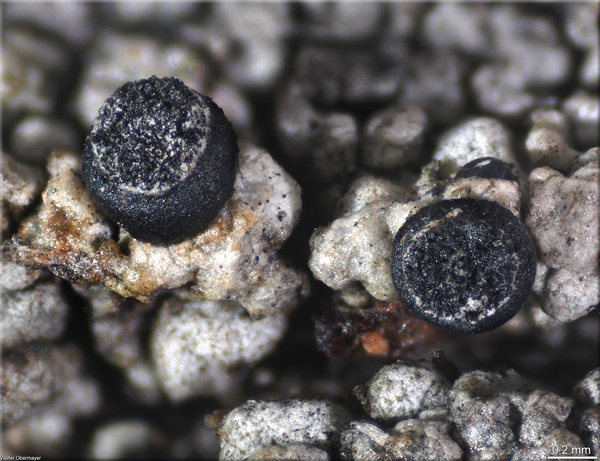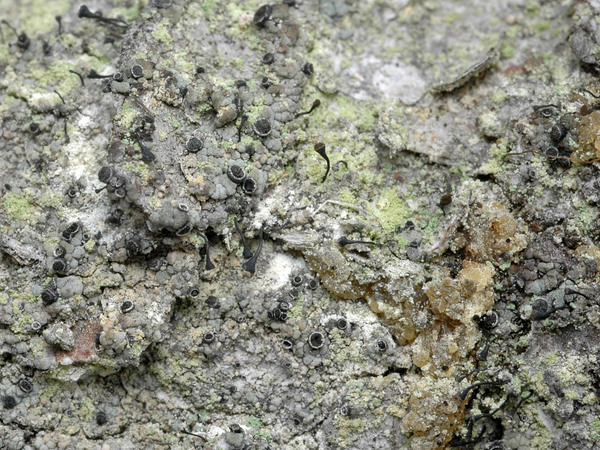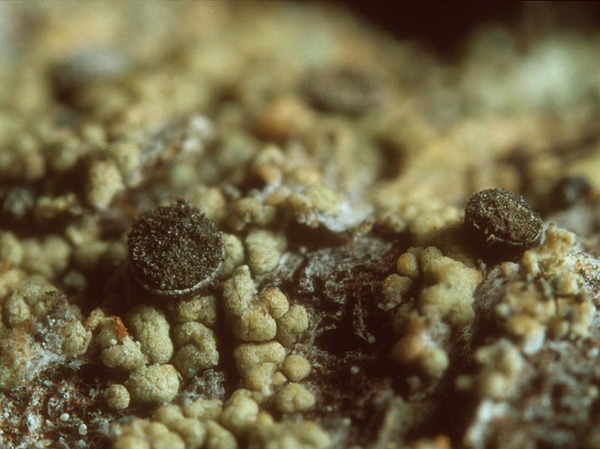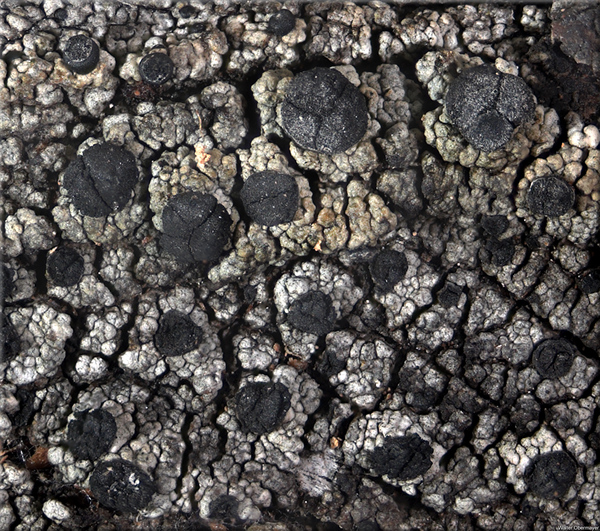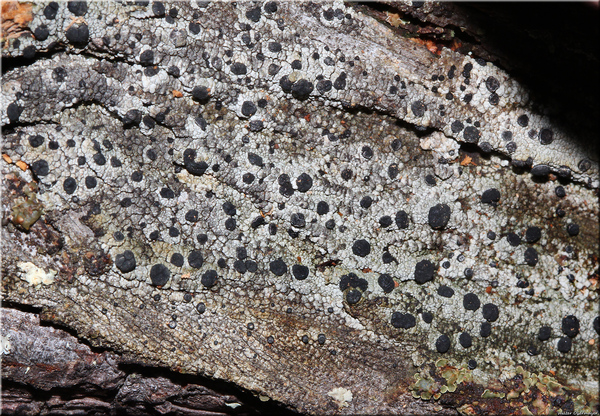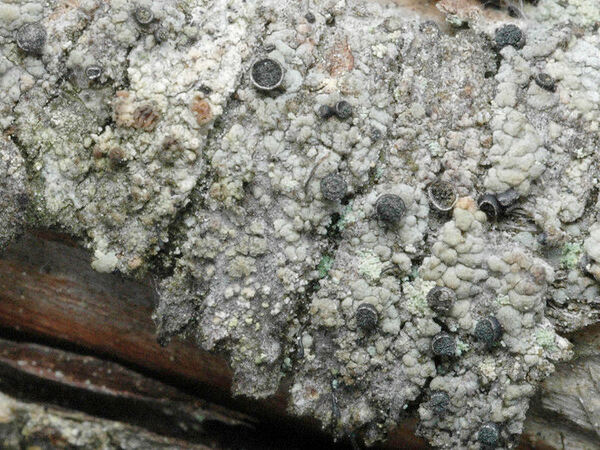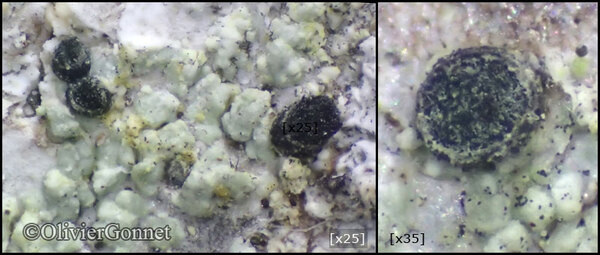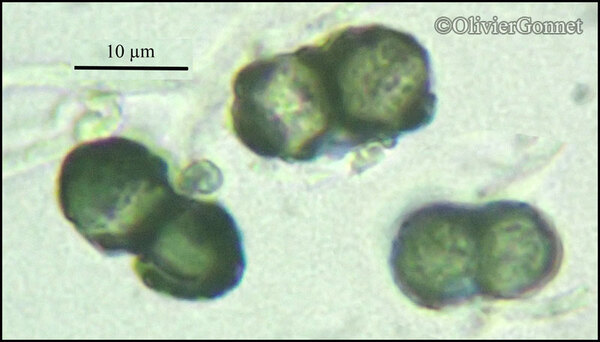Acolium karelicum (Vain.) M. Prieto & Wedin
Fungal Divers., 2016 (MB 817532). Basionym: Cyphelium lucidum var. karelicum Vain. - Acta Soc. Fauna Fl. Fenn., 57, 1: 20, 1927.
Synonyms: Cyphelium karelicum (Vain.) Räsänen
Description: Thallus crustose, episubstratic, rather thin, verrucose or subareolate, smooth, greenish grey when fresh, assuming a brownish tinge in the herbarium. Apothecia sessile, short-cylindrical or lenticular, 0.3-0.7 mm across, 0.3-0.4(-0.5) mm high, with a black, flattened mazaedium and a slightly pruinose margin. Proper exciple 40-140 µm thick laterally, expanded at the base up to 380 µm, of dark brown, sclerotized hyphae; hypothecium 110-140 µm thick, of periclinally arranged, sclerotized hyphae. Asci cylindrical, formed singly from hooked ascogenous hyphae, persisting until the spores are nearly ripe, with uniseriately arranged spores, 28-33 x 4-5 µm. Ascospores 1-septate, clearly constricted at septum, dark brown, ellipsoid, 12-17 x 7.5-10 µm, the wall at first smooth, later with cracks delimiting irregular polygonal areas. Photobiont chlorococcoid. Spot tests: thallus K-, C-, KC-, P-. Chemistry: low amounts of placodiolic acid and three unidentified substances.
Growth form: Crustose
Substrata: bark
Photobiont: green algae other than Trentepohlia
Reproductive strategy: mainly sexual
Most common in areas with a humid-warm climate (e.g. most of Tyrrenian Italy)
Commonnes-rarity: (info)
Alpine belt: absent
Subalpine belt: absent
Montane belt: very rare
Dry submediterranean belt: absent
Humid submediterranean belt: absent
Padanian area: absent
pH of the substrata:
1 2 3 4 5
Solar irradiation:
1 2 3 4 5
Aridity:
1 2 3 4 5
Eutrophication:
1 2 3 4 5
Poleotolerance:
0 1 2 3
Altitudinal distribution:
1 2 3 4 5 6
Rarity
absent
extremely rare
very rare
rare
rather rare
rather common
common
very common
extremely common
Loading data...
Occurrence data
Predictive map
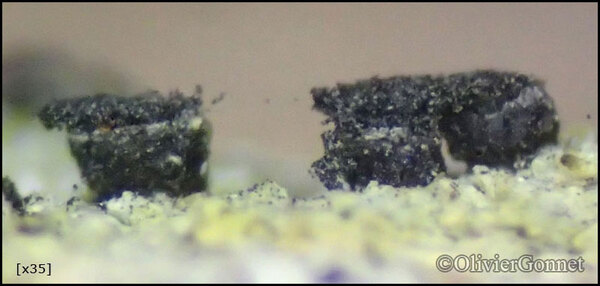
Courtesy Danièle et Olivier Gonnet - Source: https://www.afl-lichenologie.fr/Photos_AFL/Photos_AFL_A/Textes_A3/Acolium_karelicum.htm
France, sur Picea abies - Bellefontaine - Jura
14/5/2017
Growth form: Crustose
Substrata: bark
Photobiont: green algae other than Trentepohlia
Reproductive strategy: mainly sexual
Most common in areas with a humid-warm climate (e.g. most of Tyrrenian Italy)
Commonnes-rarity: (info)
Alpine belt: absent
Subalpine belt: absent
Montane belt: very rare
Dry submediterranean belt: absent
Humid submediterranean belt: absent
Padanian area: absent
pH of the substrata:
| 1 | 2 | 3 | 4 | 5 |
Solar irradiation:
| 1 | 2 | 3 | 4 | 5 |
Aridity:
| 1 | 2 | 3 | 4 | 5 |
Eutrophication:
| 1 | 2 | 3 | 4 | 5 |
Poleotolerance:
| 0 | 1 | 2 | 3 |
Altitudinal distribution:
| 1 | 2 | 3 | 4 | 5 | 6 |
Rarity
absent
extremely rare
very rare
rare
rather rare
rather common
common
very common
extremely common
Loading data...
Occurrence data
Predictive map



